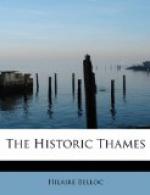With the advent of the Normans, as one might expect, municipal life to some extent re-arose. But it still maintained its distinctively English character throughout the Middle Ages. Contrast London or Oxford, for instance, in the twelfth and early thirteenth centuries, with contemporary Paris. In London and Oxford the wall is built once for all, and when it is completed the town may grow into suburbs as much as it likes, no new wall is built. In Paris, throughout its history, as the town grows, the first concern of its Government is to mark out new limits which shall sharply define it from the surrounding country. Philip Augustus does it, a century and a half later Etienne Marcel did it; through the seventeenth century, and the eighteenth, the custom is continued: through the nineteenth also, and to-day new and strict limits are about to be imposed on the expanded city.
Again the metropolitan idea, which is consonant to, and the climax of, a municipal system, is absent from the story of English towns.
Until a good hundred years after the Conquest you cannot say where the true capital of England is, and when you find it at last in London, the King’s Court is in a suburb outside the walls and the Parliament of a century later yet meets at Westminster and not in the City.
The English judges are not found fixed in local municipal centres, they are itinerant. The later organisation of the Peace does not depend upon the county towns; it is an organisation of rural squires; and, most significant of all, no definite distinction can ever be drawn between the English village and the English town neither in spirit nor in legal definition. You have a town like Maidenhead, which has a full local Government, and yet which has no mayor for centuries. Conversely, a town having once had a mayor may dwindle down into a village, and no one who respects English tradition bothers to interfere with the anomaly. For instance, you may to-day in Orford enjoy the hospitality, or incur the hostility, of a Mayor and Corporation.
On all these accounts the banks of the Thames, until quite the latest part of our historical development, presented a line of settlements in which it was often difficult to draw the distinction between the village and the town.
Consider also this characteristic of the English thing, that the boroughs sending Members to Parliament first sent them quite haphazard and then by prescription.
Simon de Montfort gets just a few borough Members to his Parliament because he knows they will be on his side; and right down to the Tudors places are enfranchised—as, for example, certain Cornish boroughs were—not because they are true towns but because they will support the Government. Once returning Members, the place has a right to return them, until the partial reform of 1832. It is a right like the hereditary right of a peer, a quaint custom. It has no relation to municipal feeling, for municipal feeling does not exist. Old Sarum may lose every house, Gatton may retain but seven freeholders, yet each solemnly returns its two Members to Parliament.




